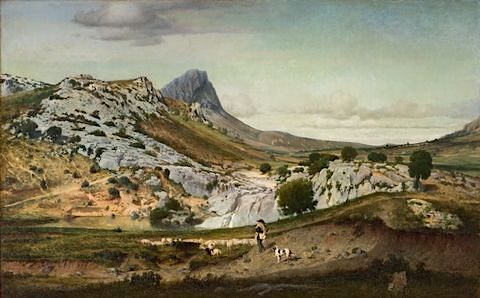JACOBUS HENDRIK PIERNEEF (1886-1957)
Somerset Sneeukop (1,590 m - 5,220 ft)
Simonsberg (1,399m - 4,590ft))
South Africa
In A view in the Stellenbosch Valley with Simonsberg and the Hottentots Holland beyond,
oil on canvas, Private collection
The mountains
Somerset Sneeukop (1,590 m - 5,220 ft) is the highest point of The Hottentots Holland Mountains are part of the Cape Fold Belt in the Western Cape, South Africa. The mountain range forms a barrier between the Cape Town metropolitan area and the southern Overberg coast.
The range is primarily composed of Table Mountain Sandstone, and forms a large range between the Cape Town outlying suburbs of Somerset West and Gordon's Bay to the west, and the large Elgin valley to the east. Sir Lowry's Pass is the only crossing, in the form of the N2 motorway. The Steenbras Dam, one of Cape Town's main supply dams, is located in the southern section of the range. This is due to the abundant rainfall experienced in the uplands, located in the Elgin Valley around the town of Grabouw on the eastern slopes.
At the start of the Great Trek in 1835 when migrants decided to leave the Cape Town area, or Cape Colony as it was then known, the first mountain range they crossed was this range.
The climate is typically Mediterranean, however it is generally much cooler and more verdant than other areas in the Western Cape, with annual precipitation exceeding 1500 mm and summertime maxima rarely exceeding 25 °C. The surrounding lowlands have rich alluvial soils supporting viticulture and other deciduous fruit farms.
Simonsberg (1399m - ) is part of the Cape Fold Belt in the Western Cape province of South Africa. It is located between the towns of Stellenbosch, Paarland Franschhoek. It is detached from the other ranges in the winelands region. Simonsberg is named after Simon van der Stel, first governor of the Cape and founder and namesake of Stellenbosch and Simon's Town.
The painter
Jacobus Hendrik (Henk) Pierneef (usually referred to as Pierneef) was a South African landscape artist, generally considered to be one of the best of the old South African masters. His distinctive style is widely recognized and his work was greatly influenced by the South African landscape.
Most of his landscapes were of the South African highveld, which provided a lifelong source of inspiration for him. Pierneef's style was to reduce and simplify the landscape to geometric structures, using flat planes, lines and colour to present the harmony and order in nature. This resulted in formalised, ordered and often-monumental view of the South African landscape, uninhabited and with dramatic light and colour.
Pierneef's work can be seen worldwide in many private, corporate and public collections, including the Africana Museum, Durban Art Gallery, Johannesburg Art Gallery, King George VI Art Gallery, Pierneef Museum and the Pretoria Art Gallery.
___________________________________________
2019 - Wandering Vertexes...
by Francis Rousseau
The painter
Jacobus Hendrik (Henk) Pierneef (usually referred to as Pierneef) was a South African landscape artist, generally considered to be one of the best of the old South African masters. His distinctive style is widely recognized and his work was greatly influenced by the South African landscape.
Most of his landscapes were of the South African highveld, which provided a lifelong source of inspiration for him. Pierneef's style was to reduce and simplify the landscape to geometric structures, using flat planes, lines and colour to present the harmony and order in nature. This resulted in formalised, ordered and often-monumental view of the South African landscape, uninhabited and with dramatic light and colour.
Pierneef's work can be seen worldwide in many private, corporate and public collections, including the Africana Museum, Durban Art Gallery, Johannesburg Art Gallery, King George VI Art Gallery, Pierneef Museum and the Pretoria Art Gallery.
___________________________________________
2019 - Wandering Vertexes...
by Francis Rousseau




















